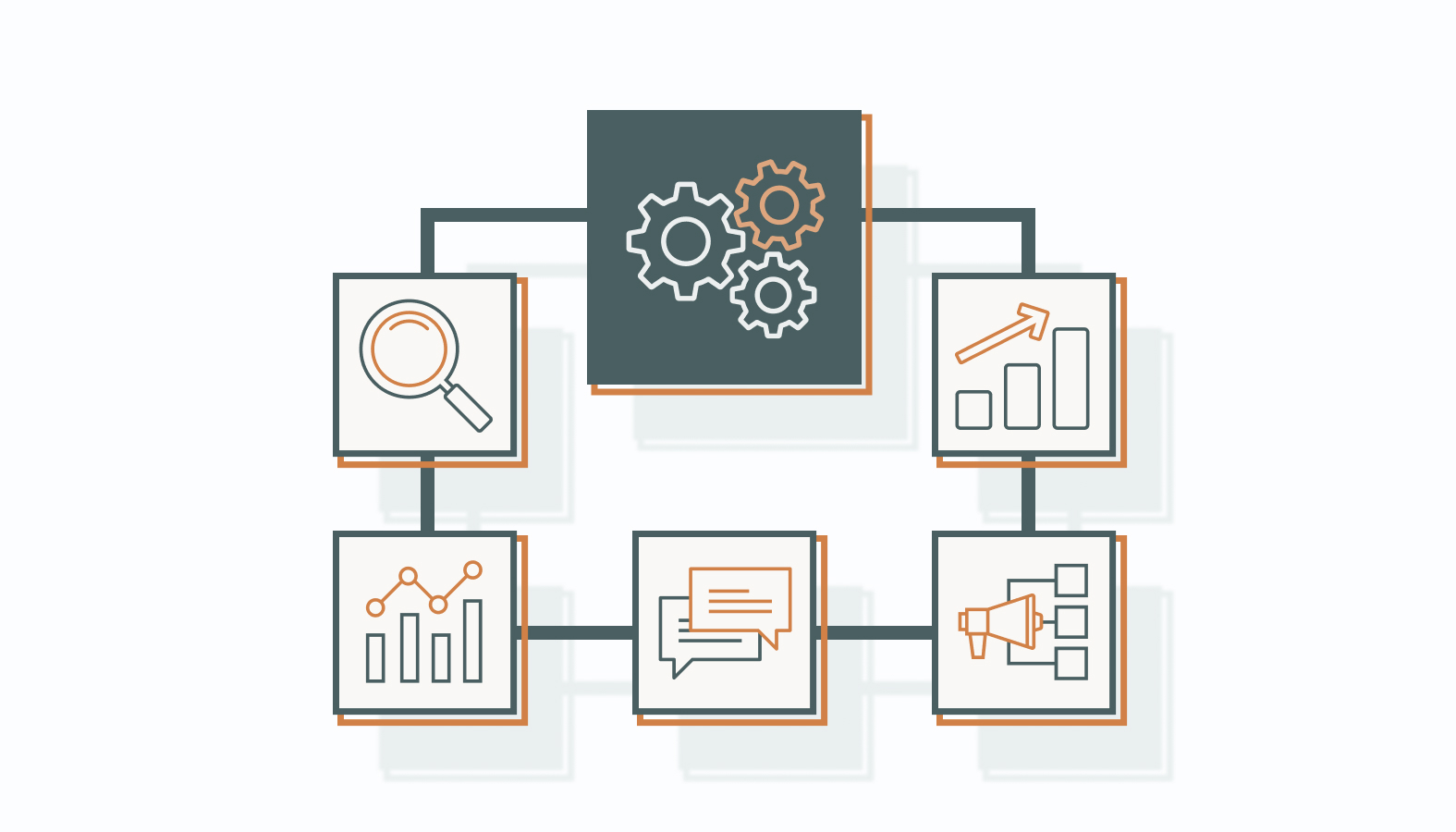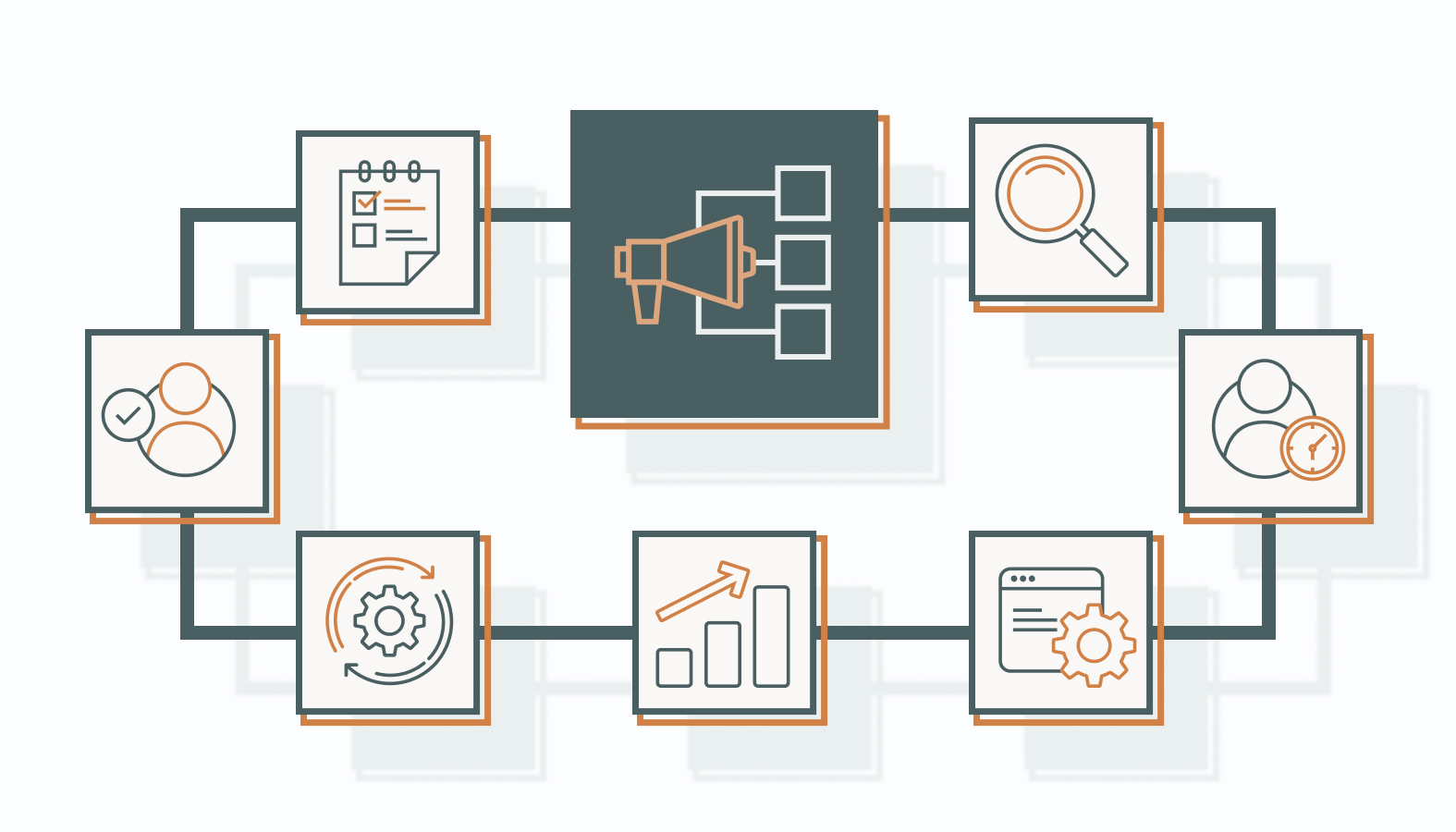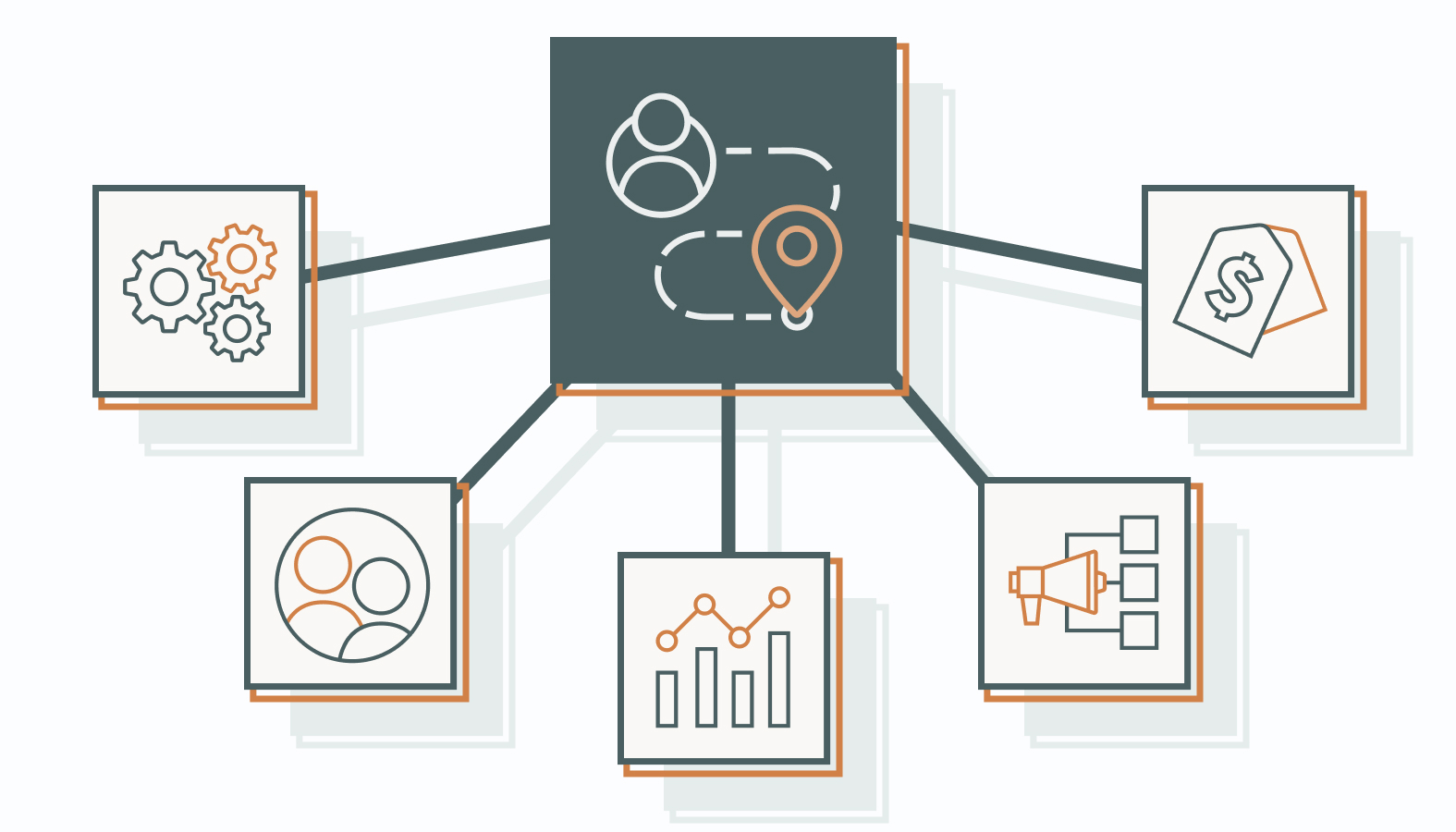New products don’t just sell themselves—especially not in 2025. The market’s louder, faster, and more crowded than ever.
You might know your customer, your value, and your story, but if your tools are scattered or outdated, your go-to-market efforts won’t land where they should. That’s why go-to-market platforms are now central to how teams plan, communicate, and sell. They help you stay organized, informed, and responsive in real time.
But not every platform is built for where business is heading next.
In this guide, you’ll learn which go-to-market platforms are set to shape 2025—and how to use them to tighten up your strategy, scale faster, and avoid common pitfalls.
Ready to sharpen your GTM game? Let’s get into it.
Understanding Go-to-Market Strategies
In today’s crowded markets, launching a product without a go-to-market (GTM) strategy is like driving blind. A GTM strategy aligns your offer with those who need it and defines how you’ll get their attention, earn their trust, and close the deal.
What is a Go-to-Market Strategy?
A go-to-market strategy is your plan for reaching the right customers with the right message at the right time. It’s not a flashy launch checklist. It’s a structured approach that connects what your business wants to achieve with what your customers actually need. Done well, it closes the gap between vision and traction.
A strong GTM strategy forces clarity. It defines who you’re targeting, why they’ll care, how you’ll reach them, and what sets you apart from everything else in the market. It aligns marketing, sales, and product teams around a shared direction, so every move supports real business outcomes.
At the core, a GTM strategy includes:
- Target Audience: You need more than demographics. You need context. Who has the problem you solve, and what drives their decisions?
- Value Proposition: This is your why-you over everyone else. It needs to be specific, relevant, and framed around outcomes your audience actually values.
- Distribution Channels: Your go-to-market path should fit your customer’s buying habits, not just your sales model. Whether digital-first, partner-led, or hybrid, reach them where they’re ready to act.
When these pieces lock into place, you move with purpose. You reduce friction, avoid distractions, and focus your effort where it counts. That’s executing like a business that knows what it’s doing.
Key Phases of a GTM Strategy
A solid strategy isn’t something you build once and forget. It’s assembled in layers, pressure-tested in real conditions, and constantly fine-tuned as the market shifts.
Each phase isn’t just a step in a process — it’s a lever to lower risk, speed up traction, and make smarter calls before launch.
Market Research
You don’t need more data. You need the right insights.
Market research is where strategy stops being a guess and starts being grounded. It’s how you move from assumptions to insights, replacing gut feel with real understanding.
When you know what your audience needs, how they think, and where others have missed the mark, you don’t just launch — you launch smart.
Use research to:
- Pinpoint customer pain points, habits, and objections
- Spot underserved segments or untapped demand
- Validate product direction before you commit serious budget
You’re not collecting data to fill a deck. You’re shaping a faster, sharper, more confident strategy.
Competitive Analysis
You’re not operating in a vacuum. Whether you like it or not, your customers already compare you to alternatives. Competitive analysis helps you understand the landscape, anticipate challenges, and precisely position your offer.
Done right, it helps you:
- See where the market is crowded — and where it’s still open
- Learn from competitor missteps without repeating them
- Shape a positioning strategy that avoids direct price or feature wars
The goal isn’t to obsess over the competition. It’s to make smarter moves by knowing what you’re walking into.
Product Positioning and Messaging
Positioning is where your product starts speaking for itself. Messaging is what makes people listen. Together, they shape how your solution lives in the minds of your customers — and how fast they decide it’s worth their time.
Effective positioning:
- Makes the value crystal clear from the first sentence
- Focuses on what matters to the buyer, not just what you built
- Stays consistent from pitch decks to landing pages to sales calls
The test? If your message can’t survive a 15-second skim, it won’t survive in-market.
Marketing and Promotion
This is where strategy meets execution. Promotion isn’t about making noise — it’s about showing up with relevance, timing, and a message that cuts through the clutter.
To execute well:
- Align your content and channels to how your audience actually buys
- Personalize by funnel stage, not just persona
- Track and iterate quickly so your team knows what’s working and what’s just noise
Your marketing should connect, not just broadcast. And once it connects, it should convert.
Launch Planning and Execution
A launch isn’t one day on a calendar. It’s a coordinated rollout that starts early, hits on time, and adapts quickly. The best launches feel effortless to the outside world because they’ve been stress-tested behind the scenes.
Strong execution includes:
- Milestones and handoffs that keep cross-functional teams aligned
- A go-live process that catches gaps before your audience does
- Systems in place to monitor performance and respond in real-time
A smooth launch doesn’t mean nothing goes wrong. It means you’re ready when it does.
By carefully crafting and executing each phase of a GTM strategy, businesses can significantly enhance their market entry success and build lasting relationships with their customers.
Leading Go-to-Market Platforms to Watch in 2025
The right tools don’t just support your go-to-market strategy; they accelerate it.
As we head into 2025, a new wave of GTM platforms is reshaping how brands launch, scale, and stay competitive. These aren’t just software licenses. They’re growth engines, data hubs, and customer experience multipliers.
Here’s a closer look at the platforms leading the charge and why they deserve a spot in your GTM stack.
HubSpot
HubSpot is built for GTM teams that want everything — marketing, sales, and service — to work from the same playbook. Modular, scalable, and intuitive, it gives growing businesses the structure they need without adding complexity.
Key Features
HubSpot unifies your GTM motion in one connected platform:
- CRM, marketing automation, CMS, and service tools under one roof
- Native integrations with thousands of apps for clean data sync
- Real-time engagement tracking and reporting
- Workflow automation that saves time and reduces busywork
Everything is built to work together, so your team isn’t constantly bridging tool gaps.
User Benefits
HubSpot helps you move faster and smarter:
- Intuitive interface with minimal ramp-up
- No dev-heavy setup required
- Inbound framework that drives traffic, nurtures leads, and builds loyalty
- Full-funnel visibility to track what’s working and double down
It connects your entire revenue engine, so you’re not guessing but optimizing.
HubSpot Price: The CRM is free and powerful on its own. Paid Hubs start around $50/month and scale with usage. It’s a wise investment when alignment, automation, and visibility are critical to growth.
Cognism
Cognism is built for B2B sales teams that want more than just contact lists. It delivers precision, compliance, and speed — everything a modern GTM team needs to build a pipeline without the guesswork.
Key Features
Cognism turns raw data into sales-ready insights with:
- A verified global database of decision-makers
- AI-driven intent signals to surface buyers who are actually in-market
- Real-time enrichment with up-to-date firmographic and behavioral data
- CRM and sales tool integrations for frictionless workflows
- GDPR-compliant sourcing to keep outreach clean and above board
This isn’t lead gen. It’s intelligent prospecting that cuts the noise.
User Benefits
Cognism helps sales teams:
- Focus on prospects likely to convert
- Skip manual research with enriched, ready-to-use data
- Ramp faster with tools that plug into your existing stack
- Minimize legal risk with built-in privacy compliance
The result: fewer dead ends and more qualified conversations.
Cognism Price: Pricing is customized based on team size, territories, and data scope. You’re not buying bulk leads. Instead, you’re investing in a pipeline engine tailored to your market.
Kaspr
Kaspr is a fast, lightweight lead gen tool built for B2B teams that live on LinkedIn. It gives sales reps instant access to verified contact data, right where they’re already prospecting. No tab-switching, no spreadsheets, just clean data and smooth workflows.
Key Features
Kaspr speeds up top-of-funnel prospecting with:
- LinkedIn data extraction for emails and phone numbers
- A Chrome extension for in-platform prospecting
- Contact enrichment to verify and enhance lead profiles
- Automated workflows to push leads into your CRM
- Real-time syncing for always-fresh contact info
It’s more than a scraper; it’s a prospecting sidekick built for momentum.
User Benefits
Kaspr helps sales teams:
- Prospect without leaving LinkedIn
- Cut research time dramatically
- Fill the CRM with verified, ready-to-outreach leads
- Move from profile view to personalized pitch in minutes
Perfect for lean teams that value speed, accuracy, and simplicity.
Kaspr Price: Free plans offer limited daily credits for light use. Paid tiers start at €30/month, scaling based on volume and features. For small teams or growing orgs, it’s a low-lift way to boost outbound without the overhead.
Salesforce
Salesforce remains the benchmark for CRM platforms. It’s a contact database and growth engine built to unify sales, marketing, and service around a single source of truth. If scaling with precision is the goal, Salesforce gives you the infrastructure to make it happen.
Key Features
Salesforce’s cloud platform is modular, customizable, and enterprise-ready:
- Sales Cloud for lead management, pipeline tracking, and sales automation
- Service Cloud for multichannel customer support and ticket resolution
- Marketing Cloud for personalized, cross-channel campaigns and journey-building
- Real-time analytics with customizable dashboards and forecasting
- AppExchange with thousands of plug-and-play integrations
- Custom app development via the Salesforce Platform for tailored solutions
Everything connects in the cloud, giving your team a complete view of the customer journey.
User Benefits
Salesforce adapts as your business grows:
- Automates repetitive sales and service tasks to save time
- Centralizes customer data to power personalized engagement
- Scales effortlessly across teams, roles, and markets
- Delivers enterprise-grade security and compliance
- Integrates cleanly with your broader GTM stack
It’s the CRM that keeps pace with your ambitions.
Salesforce Price: Plans start at $25 per user/month for the Essentials package. Advanced tiers scale by user roles and feature depth. When configured well, the alignment, visibility, and automation it unlocks easily justify the spend.
Shopify
Shopify is the go-to ecommerce platform for brands that want to launch fast, scale smart, and stay in control. Whether you’re building from scratch or managing a multi-product storefront, Shopify handles the tech so you can focus on selling.
Key Features
Shopify streamlines online selling with:
- Customizable storefronts and drag-and-drop editing
- Built-in payment processing and integrations with major gateways
- Inventory and order management across products, variants, and locations
- Multi-channel selling on Amazon, Instagram, TikTok, and more
- A massive app marketplace to expand functionality without code
- Mobile tools so you can manage your store anywhere
Everything lives in one clean, intuitive dashboard.
User Benefits
Shopify delivers the speed and flexibility modern brands need:
- Fast setup with minimal technical lift
- Built-in scalability as your catalog, team, or traffic grows
- Thousands of plug-and-play integrations
- A smooth backend that lets you focus on revenue, not roadblocks
Whether you’re a solo founder or scaling fast, Shopify moves with you.
Shopify Price: Basic plans start at $29/month, with Advanced and Plus tiers for higher-volume needs. Shopify is flexible, transparent, and built to grow alongside your business.
Amazon Web Services (AWS)
AWS powers the digital backbone of everyone from scrappy startups to global giants. If your go-to-market strategy needs speed, scale, or serious computing power, this is where you plug in.
Key Features
AWS offers a robust suite of services, including:
- EC2 for scalable virtual servers
- S3 and Glacier for secure, tiered storage
- RDS and DynamoDB for relational and NoSQL databases
- SageMaker for AI and machine learning deployment
- CloudFront for global content delivery
- Enterprise-grade security with encryption and access control
Whether you’re spinning up a prototype or managing petabytes of data, AWS has the range.
User Benefits
What makes AWS indispensable is what it enables:
- On-demand scalability for launches, spikes, or steady growth
- Global infrastructure with rock-solid uptime
- Integrated developer tools that play well with modern stacks
- Security and compliance trusted by highly regulated industries
It’s the quiet force behind many of the world’s most resilient GTM engines.
AWS Price: AWS uses a pay-as-you-go model. No contracts, no fluff—just clean, usage-based pricing for the power you need, when you need it.
LinkedIn isn’t just for networking. For B2B teams, it’s where buyers engage, influence gets built, and deals take shape.
Whether you’re running top-of-funnel brand plays or zeroing in with outbound, LinkedIn gives you the tools and context to show up with credibility.
Key Features
LinkedIn supports your GTM motion with a blend of organic and paid tools:
- Company Pages to build brand presence and share thought leadership
- Sponsored Content and InMail Ads for precise outreach by role, industry, and behavior
- Sales Navigator with advanced lead search, account insights, and smart recommendations
- Built-in analytics to track engagement, audience growth, and campaign performance
- Network visibility that surfaces mutual connections and intro paths
It’s not just where professionals scroll—it’s where B2B buying decisions start.
User Benefits
LinkedIn puts you in front of the right people, faster:
- Increases visibility with high-intent, high-value audiences
- Helps reps warm up leads before outreach
- Aligns sales and marketing around shared targets
- Provides real-time insight into who’s engaging and how
For modern B2B teams, LinkedIn is both the map and the territory.
LinkedIn Price: The core platform is free. Premium tools like Sales Navigator start at $64.99/month, with pricing scaling by features and team size. For B2B brands, it’s a direct line to the people who matter.
Slack
Slack goes beyond being a messaging app. It supports fast-moving GTM teams. When sales, marketing, and product need to sync without friction, Slack turns everyday communication into real-time execution.
Key Features
Slack brings clarity and speed to team collaboration with:
- Channels for organized, topic-based discussions across teams and projects
- Direct Messaging for quick, focused chats
- File Sharing with drag-and-drop ease and full searchability
- Workflow Builder to automate tasks like standups, approvals, and onboarding
- App Integrations with 2,000+ tools, including Salesforce, HubSpot, Asana, and Google Drive
- Slack Connect for seamless, secure comms with vendors and clients
It’s how high-velocity teams stay aligned without extra overhead.
User Benefits
Slack helps GTM teams move faster and stay on the same page:
- Cuts decision time by eliminating email delays
- Centralizes updates, files, and conversations in one place
- Reduces meetings through async check-ins
- Keeps remote and hybrid teams agile and responsive
If coordination is critical, Slack keeps the gears turning.
Slack Price: Slack’s free tier covers the basics. Paid plans start at $6.67 per user/month, adding full message history, admin tools, and deeper integrations. For most teams, the ROI on alignment pays for itself fast.
MailChimp
Mailchimp has grown from a scrappy email tool into a surprisingly robust all-in-one marketing platform. Whether you’re nurturing leads, re-engaging customers, or launching a new campaign, Mailchimp delivers pro-level tools without the heavy tech lift.
Key Features
Mailchimp helps you build, automate, and optimize with:
- Drag-and-drop builder and polished templates for brand-ready emails
- Marketing automation for welcome flows, follow-ups, and cart recovery
- Smart segmentation based on behavior, tags, and purchase history
- Pre-built journeys to guide customers through the funnel
- A/B testing and analytics to refine messaging and track ROI
- Integrations with Shopify, Salesforce, Stripe, and more
It’s built for agility, easy for small teams, and powerful enough to scale.
User Benefits
Mailchimp makes modern marketing accessible:
- Launch professional campaigns without a designer or developer
- Automate repetitive tasks and stay focused on strategy
- Personalize outreach with real-time audience targeting
- Track performance with visual dashboards and clear metrics
For lean GTM teams, it’s a fast, flexible way to create meaningful customer touchpoints.
Mailchimp Price: Mailchimp’s free plan handles the basics. Paid tiers start at $13/month, unlocking automation, advanced segmentation, and larger contact limits. It’s priced to grow as you do.
Google Marketing Platform
Google Marketing Platform is the control center for performance-driven marketers. By unifying advertising and analytics, it helps GTM teams plan smarter, move faster, and optimize every campaign with precision.
Key Features
The platform brings together a suite of powerful tools:
- Google Analytics for behavioral insights, attribution, and conversion tracking
- Google Ads for search, display, and campaign optimization
- Display & Video 360 for managing programmatic media across channels
- Search Ads 360 for enterprise-grade SEM with automation and bidding tools
- Tag Manager to simplify tracking without developer bottlenecks
- Data Studio for building dashboards and visualizing cross-channel performance
It’s built for teams that need real-time visibility and unified performance control.
User Benefits
Google Marketing Platform turns insight into impact:
- Unify data across campaigns, channels, and audiences
- Use AI-powered insights to guide decisions and budget allocation
- Coordinate multichannel campaigns from one dashboard
- Improve ROI with precision targeting and real-time optimization
Whether you’re managing a single funnel or a global campaign portfolio, it keeps your efforts aligned and accountable.
Google Marketing Platform Price: Many tools like Google Analytics and Tag Manager are free for standard use. Enterprise-level solutions such as GA4 360, DV360, and Search Ads 360 are priced based on usage and scale.
These platforms are poised to shape GTM strategies in 2025, delivering smarter ways to boost efficiency, deepen engagement, and accelerate growth.
Building a GTM Stack That Works Like a System
A modern go-to-market strategy doesn’t just need good tools—it needs the right ones working together like a system. When your GTM stack is built with intention and integration, your teams stay aligned, your data stays clean, and your execution gets sharper with every iteration.
Instead of a scattered collection of apps, you get a connected system that powers growth. There’s less chaos, more clarity, and better results.
1) Assess Your Process Before Picking Tools
Start with the reality on the ground.
Where are leads dropping off?
Are teams duplicating efforts?
Are dashboards telling different stories?
Map your current workflows, identify friction points, and look for tools that solve those issues directly.
Prioritize platforms that are intuitive, interoperable, and built to support how your team actually works, not just how vendors pitch it.
2) Define Use Cases and Ownership
Every tool should have a job—and a person accountable for it.
Write down what each tool is for, how it fits into your GTM flow, and who’s responsible for managing it.
If ownership is vague or use cases are undefined, the tool won’t get used correctly. Accountability turns software into strategy.
3) Align Data, Don’t Just Integrate
It’s not enough to connect tools. They have to speak the same language.
Standardize your data fields, sync key workflows, and ensure updates flow bi-directionally without manual cleanup.
When marketing, sales, and ops are all working from the same dataset, alignment becomes a natural byproduct—not a daily battle.
4) Design for Scale, Not Just Speed
A stack that only works at your current size will bottleneck your growth.
Choose tools that scale with you—more users, more automations, more complexity. Look for transparent pricing models and flexible infrastructure.
Growth should stretch your strategy, not snap your systems.
5) Workflow First, Feature Set Second
Features are meaningless if they don’t fit your team’s daily rhythm.
Start with how your team actually works:
- How a lead flows from awareness to conversion.
- How teams hand off deals.
- How customer feedback loops back into product.
Then find tools that support those flows without friction. If it doesn’t serve the workflow, it doesn’t belong in the stack.
6) Train With Purpose, Not Just Access
Untrained teams don’t adopt tools—they ignore them.
Build onboarding that focuses on the most relevant actions. Use cheat sheets, quick wins, and internal champions to drive adoption. Your goal isn’t feature familiarity. It’s confident execution that compounds over time.
7) Audit, Optimize, Repeat
Every tech stack drifts toward complexity. Don’t let it.
Run quarterly reviews to assess performance, usage, and overlap. Eliminate underused tools, consolidate where you can, and re-evaluate fit as your GTM strategy evolves. A lean, intentional stack is easier to manage and much harder to break.
When your stack is integrated, your workflows are intentional, and your team is fully bought in, your GTM strategy stops relying on brute force. It becomes a system that compounds—fast, flexible, and built to scale.
Learning from Real-World Case Studies and Success Stories
The best way to understand the impact of a strong GTM stack? See it in action. These real-world examples show how top companies align their tools with strategy—not the other way around.
Zendesk Syncing Service and Sales
Zendesk’s integration with Salesforce shows how smart connections reduce friction.
- Centralized customer data gives teams full context for every interaction
- Faster, more informed support thanks to shared history across platforms
- Fewer handoff errors, better CX, and tighter feedback loops
Airbnb: Smarter Ad Spend With Google Marketing Platform
Airbnb used Google’s suite to bring precision to their paid media strategy.
- Unified analytics gave Airbnb a clearer view of user behavior
- Ad performance improved by targeting high-intent segments
- Better insights led to better decisions—and better ROI
Netflix: Global Scale on AWS
Netflix runs on AWS, and it’s not just about uptime—it’s about delivering at scale.
- Cloud infrastructure supports global content delivery with zero lag
- Scalable compute power keeps performance high, even under heavy demand
- Streaming stays smooth, no matter where or when users press play
Spotify: Personalized Powered by Google Cloud
Spotify’s recommendation engine gets its horsepower from Google’s AI.
- Machine learning models refine music suggestions in real time
- Massive data handling powers personalized experiences for millions
- Google Cloud lets Spotify scale fast without skipping a beat
None of these brands chase shiny features—they build stacks that scale, sync, and drive outcomes. The lesson: integration isn’t about convenience. It’s about competitive advantage.
Anticipating Future Shifts in Go-to-Market Platforms
The GTM landscape isn’t sitting still. Emerging trends are reshaping how businesses connect with buyers, orchestrate operations, and scale revenue. The smartest teams aren’t reacting—they’re already building for what’s next.
Here’s what to expect and how to get ahead of it.
AI is the New Engine
Artificial intelligence (AI) and machine learning are no longer nice-to-haves—they’re foundational.
- Smarter Targeting: AI parses mountains of data to surface buying signals and predict intent. That means sharper targeting and better-timed outreach.
- Dynamic Experiences: From content personalization to chatbots that don’t feel robotic, AI is turning one-size-fits-all into one-to-one engagement.
- Faster Feedback Loops: Real-time optimization lets you pivot mid-campaign, not post-mortem.
CDPs Will Become Non-Negotiable
Customer Data Platforms (CDPs) are becoming the GTM command center.
By unifying behavioral, transactional, and demographic data, they give teams a single, reliable customer profile. That means marketing, sales, and service finally operate from the same playbook—no silos, no guesswork, just aligned execution that moves faster and hits harder.
Data Analytics Will a Promotion
Data only creates value when it drives action. The next evolution of analytics is predictive and real-time, enabling smarter decisions on the fly.
Granular attribution, funnel diagnostics, and campaign insights give teams the visibility to adjust quickly and with precision.
The result is sharper focus, fewer wasted moves, and strategies that respond as fast as the market shifts.
Omnichannel Won’t Be Optional Anymore
Omnichannel isn’t optional anymore. Your customers move fluidly between platforms, and your GTM motion needs to match that agility.
Integrated journeys ensure your messaging stays consistent—whether someone clicks an ad, visits your site, or talks to a sales rep.
When engagement is seamless across email, social, chat, and sales, the experience improves, trust builds, and conversion rates follow.
Subscription Models to Reshape Revenue
More companies are trading one-time wins for recurring relationships.
- Loyalty Over Transactions: Subscriptions shift focus from acquisition to retention, building long-term customer value.
- Predictable Growth: With recurring revenue, forecasting gets easier and lifetime value goes up.
Staying ahead of GTM platform shifts is necessary to remain competitive. As these trends reshape how teams operate, the businesses that adapt early will be the ones that grow faster, execute sharper, and win more consistently in a changing market.
Connect the Dots: Build a GTM Strategy That Scales
Tools don’t build growth; systems do. The best go-to-market strategies aren’t just powered by tech; they’re shaped by how that tech fits together. When your platforms talk to each other, your teams move faster, your data gets smarter, and your execution sharpens.
Integrated GTM platforms give you more than automation—they provide you with leverage. You get clarity across the funnel, visibility into what’s working, and the speed to pivot when it’s not. That’s how modern teams outpace competitors: not with more tools, but with the right ones, connected by design.
Audit your stack, close the gaps, and cut what slows you down. If you want a partner who’s done this before, we’re ready. Schedule a candid conversation with one of our experts, and let’s build a stack that drives revenue on purpose.









